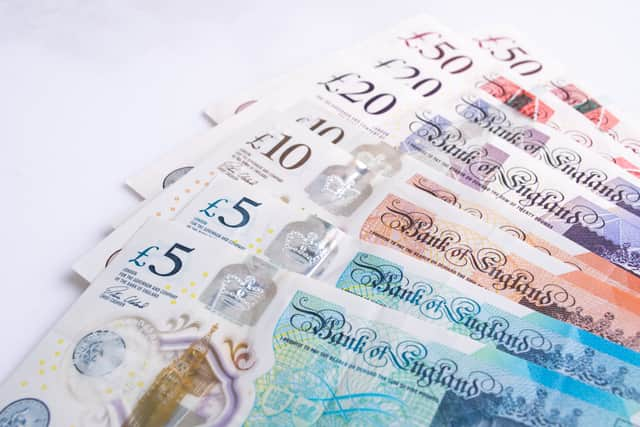Student loan repayments: what is current interest rate, how much will it go up by - and for how long?
and live on Freeview channel 276
The cost of living crisis has deepened this week for households up and down the UK after it was revealed inflation had hit a new 30 year high and wages are not keeping up.
Cost increases are being felt across the economy, with fuel prices and food costs among the categories to have seen the biggest increases.
Advertisement
Hide AdAdvertisement
Hide AdAs a result of rises to Office for National Statistics (ONS) inflation yardsticks the CPI and RPI, index-linked bills - such as broadband bills and student loan repayments - are also being forced up.
So, if you’re paying back a student loan, how much extra will you be forking out to pay for your university degree?
Here’s what you need to know.


What are student loans?
The student loan is an amount of money that’s lent to English and Welsh students who are studying for university degrees.
In 2012, these loans became the principal way in which universities were funded as the government abolished teaching grants and raised student loans from a £3,000 a year cap to a £9,000 a year cap.
Advertisement
Hide AdAdvertisement
Hide AdStudents also receive maintenance loans to cover their living costs.
At the time the student loan changes were announced, it was argued this change was necessary to take higher education costs away from taxpayers and place them instead onto the individuals who were going to university.


People who started studying at university from the 2012/13 academic year onwards are required to pay back the loans with the interest they pay dependent on their income and the Retail Price Index - a measure of inflation calculated by the ONS.
Those earning under £27,295 (£2,274 a month) before tax and other deductions currently do not have to pay their loans back.
Advertisement
Hide AdAdvertisement
Hide AdAnd if you never earn over the repayments threshold or have not earned enough to pay the entire loan back 30 years after you started repaying it, your tuition fees will be written off by the government.
What is the current student loan interest rate?
While you study, a flat rate of interest is added to your loan - currently 4.1%.
For graduates, the current maximum rate of interest added to their loan is 4.5%.
This is because the RPI in March 2021 was 1.5% and students can have up to 3% added on top this rate.


Advertisement
Hide AdAdvertisement
Hide AdThis is how much interest is added to your loan depending on how much you earn:
- £27,295 or less (flat RPI rate - 1.5%)
- £27,296 to £49,130 (RPI rate plus up to 3%)
- Over £49,130 (RPI rate plus 3%)
If you earn a wage that’s above the repayments threshold, 9% of your earnings over that amount will be deducted to repay your student loan.
How much will student loan interest rate rise by?
From September 2022 - i.e. the start of the next academic year - former students will see the amount of interest added to their student loans topping 12%.
This is because the RPI for March 2022 is sitting at 9%.
The Institute for Fiscal Studies (IFS) described this increase as “eye-watering” and said it would mean recent graduates are paying “vastly more” than average mortgage rates and interest rates on unsecured credit.
Advertisement
Hide AdAdvertisement
Hide Ad“Student loan borrowers might legitimately ask why the Government is charging them higher interest rates than private lenders are offering,” the IFS said.


It means that over just a six-month period, high-earning graduates with a typical loan balance of £50,000 will see another £3,000 in interest added to their debt.
However, after six months, a law that prevents student loan interest rates from exceeding interest rates “prevailing on the market” - i.e. those applied to unsecured commercial loans - will kick in.
According to IFS estimates, it means interest will fall to 7% from March 2023 and will then fluctuate between 7% and 9% until September 2024, when the rate will go down to 0% for six months before popping back up again to around 5% in March 2025.
Advertisement
Hide AdAdvertisement
Hide AdIt means graduates will face a “rollercoaster ride” of inflation rates that would disadvantage former graduates who’re paying back their student loans but benefit current students whose debts are still rising.
The IFS also warned it could also put students off going to university, or push graduates to pay off loans when this would have no financial benefit for them.
“Unless the Government changes the way student loan interest is determined, there will be wild swings in the interest rate over the next three years” said Ben Waltmann, senior research economist at the IFS.
“The maximum rate will reach an eye-watering level of 12% between September 2022 and February 2023 and a low of around zero between September 2024 and March 2025.
Advertisement
Hide AdAdvertisement
Hide Ad“There is no good economic reason for this. Interest rates on student loans should be low and stable, reflecting the Government’s own cost of borrowing.
“The Government urgently needs to adjust the way the interest rate cap operates to avoid a significant spike in September [2022].”
Save the Student, a pressure group for current and recent students said the September spike would be “yet another blow” to young people already battling the cost of living crisis.
“For lower earners whose loans accrue interest at the rate of RPI only, the use of March's figure would mean that, come September, their interest rate will be six times higher than it is now,” said Tom Allingham, Save the Student's head of editorial.
Advertisement
Hide AdAdvertisement
Hide Ad“It's worth noting that, as graduates only ever repay a percentage of their earnings over a threshold, any change to the interest rate won't affect the amount people repay each month.
“However, higher interest rates do mean larger overall debts, which in turn means the loan takes longer to repay for those who may otherwise have done so earlier.”
Student loan changes from 2023
It all comes after the government announced in February that students beginning their degrees in September 2023 in England will face a different student loan system.
Rather than writing off loans after 30 years, the government will write them off after 40 years.
Advertisement
Hide AdAdvertisement
Hide AdIt means higher-earning graduates will pay less overall as they will pay back their loan more quickly.
Meanwhile, middle-earning graduates will be set to repay more than they do under the current system, while students will start repaying their loans once they reach a £25,000 threshold.
Those studying and those who have graduated will also face interest rates that will be fixed at RPI only, with no additional percentages added as they currently are.
Comment Guidelines
National World encourages reader discussion on our stories. User feedback, insights and back-and-forth exchanges add a rich layer of context to reporting. Please review our Community Guidelines before commenting.
